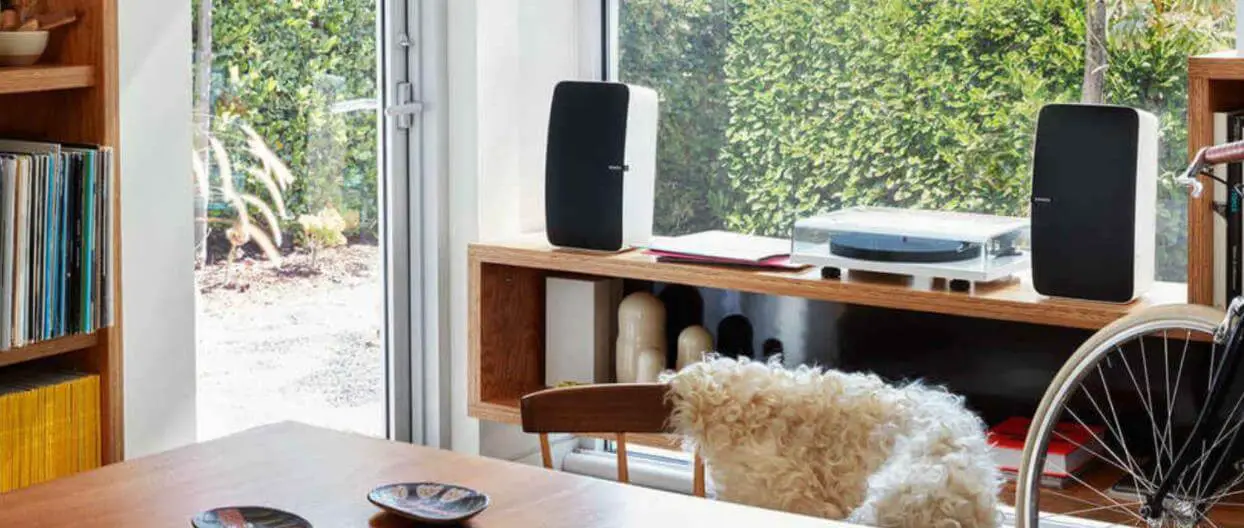Sonos Five Wireless Speaker Review
The new Sonos Five was one of three new products launched in June 2020 along with the Sonos Arc soundbar and Sonos Subject 3 subwoofer. It has replaced the hugely popular Play 5 model, which was the first all-in-one wireless speaker. It can be used on its own in a stereo pair as rears or as part of a whole-house wireless setup. Sonos Five is the most massive standalone speaker that Sonos offers and provides studio-quality stereo sound to fill a large room.
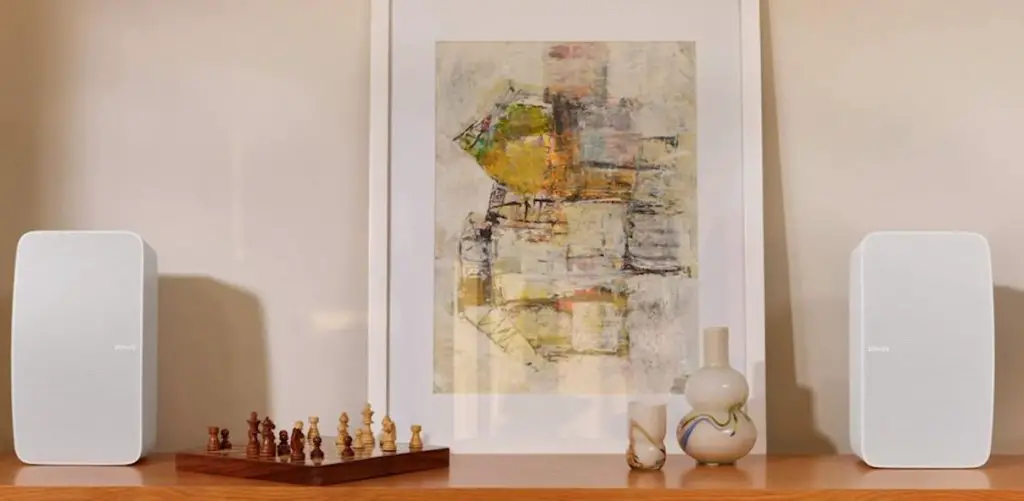
Design
If we look at the design, the Five has had a bit of a refresh, and if we put it side by side next to the older Play 5, you can see some slight changes. The new Five is much more in line with the style of the latest Sonos products, such as the Sonos 1 and Sonos arc, with a more modern and sleek feel. This perforated grill across the front is now color-matched with the rest of the speaker, offering an all-white or all-black design instead of the older white Play Five with a white body but retained the black front. The logo on the front is also more discreet on this new design. Otherwise, the design is the same as the Play 5 with the touch panel controls on the top for Play, pause, changing the volume or skipping a track. It’s also the same size and shape and has the same ports on the back. So it’s got an Ethernet port, a power port, a join button and a handy 3.5-millimeter jack for line in which I’ll discuss later on in the post.
Both models have these little rubber feet on three sides as they can be stood in two different orientations, vertical or horizontal. These feet prevent any damage to the surface you place it on. I’ll also point out that the Five, like the Play 5, is humidity resistant. So it can be positioned in human environments such as a bathroom or conservatory.
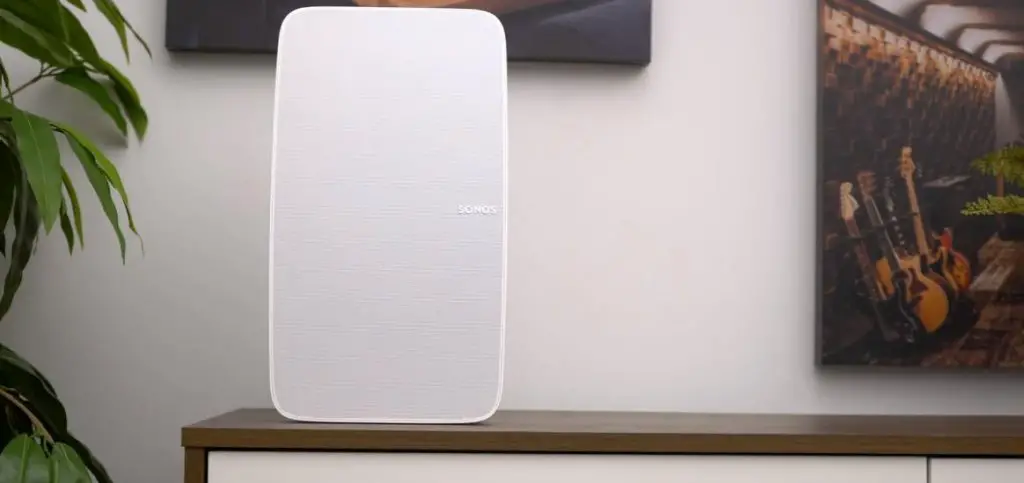
Let’s move on to the main difference between the Five and the Play 5. That’s updated internals, including future-ready computing hardware. The new 5 offers increased memory and processor in power and BLE, which stands for Bluetooth low-energy and NFC (Near Field Communication) for a Swifter setup process. An updated wireless radio provides a more stable and robust Wi-Fi connection allowing the Five to be situated further away from your wireless router. It’s also worth mentioning that as these speakers are smart speakers, they come with internal processes. So the Five has been updated with a quad-core 1.3 gigahertz CPU processor, which could power a laptop computer. This may be overkill. For now, it offers excellent scope for what could be possible in the future. Sonos also purchased some small tech companies over the last 18 months, so we’re excited to see what Sonos will do with these technologies.
While the Play 5 is compatible with both the old Sonos s1 app and the new s2 app, the new Five will only work with s2. This means if you have any legacy products in your home, a new Five would need to be set up on a different system in s2 and couldn’t be grouped with those older products. So that wraps up the main differences.
Let’s talk about some of the similarities between these two models. First and foremost, the Five has retained the same internal speakers and sounds like the famous Play 5. Inside there are six matching Class D amplifiers with three custom-designed, ten-centimeter mid-woofers, which are placed at the bottom of the speaker and three tweeters along the top for the vocals and high frequencies. The left and right tweeters are directed out to the sides in a phased array design to offer a wider soundstage, and they fill a large room comfortably.
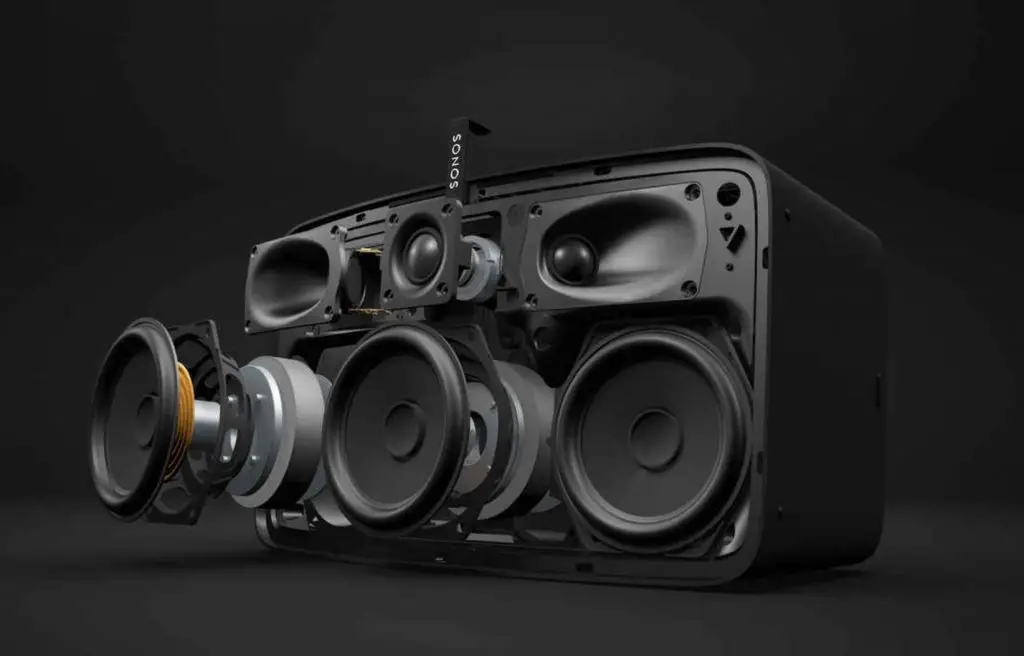
A sealed architecture prevents any reverb and echo, so you only hear what you want to hear. As I mentioned earlier, the Five can be used on its own or in a stereo pair. A 5 alone will automatically separate the left and the right channels to provide impressive stereo sound. You can take it to the next level with a pair for an accurate stereo soundstage. In this configuration, the speakers will automatically adjust to Mono mode to offer a more detailed stereo separation, bring out the vocals instruments and little details in the way the artist intended.
Unfortunately, though, you can’t get a stereo pair of one Five with one Play 5. It would have to be a pair of the same models for this setup, which is a bit of a shame if you’ve already got to Play Five and are looking to create a stereo pair.
The Sonos 5 also benefits from a dedicated 3.5-millimeter jack, which allows you to connect an external device such as a CD Player or a turntable. This is an effortless way of enjoying your vinyl records on a wireless speaker. Being part of the Sonos ecosystem, a big plus of this setup is that you can send the audio to any other Sonos devices in your house. For example, you could have a Five connected to a turntable in your office and then send that audio to a Sonos one in your lounge to enjoy the sound of vinyl throughout your home. This is one of my favorite setups at smart home sounds because you can capture the emotions and the ownership of the vinyl and benefit from convenient wireless streaming using the Sonos ecosystem when you want to. I also have to point out the line in the autoPlay feature, which means that it will automatically switch to the line-in input once it senses a signal once enabled. So in the turntables case, that’s when the needle hits the vinyl, so no button pressing is required.
Features
Let’s move on to some additional features. Like other Sonos speakers, the Five can be controlled in several ways. The Sonos app can be used to tweak EQ settings, such as bass and treble, Play radio stations and stream from over a hundred streaming services, including Spotify, Apple Music, Tidal and more. The 5 is also AirPlay 2 compatible so that you can cast audio straight from an iOS device to the speaker, or you can use Spotify Connect to stream directly from the Spotify app using a smart device.
There’s no Bluetooth in this model, which will be a drawback for some. But the reason for this is that Sonos wants to keep Bluetooth for portable speakers and have already done this in their Sonos Move Bluetooth speaker, which you can take outside the home and enjoy indoors. Wi-Fi through the form of the Sonos app Spotify connect or airPlay to is a much more robust form of control for listening at home. Because it doesn’t interrupt the listening experience from other sounds from your phone, it doesn’t drain your device’s battery, and it lets you roam around your home without range issues.

True Play tuning can also be used to enhance the audio quality of the 5 for the room you’re in. Using the Sonos app on an iOS device, the speaker will emit test tones to detect your room and furniture’s size and layout. It will then automatically adjust the EQ settings for the best possible performance in that room. I am a hundred percent recommend this and what I like is so nice gives you the ability to toggle this on and off to hear the speakers’ audio changes. I am always skeptical of room tuning software that doesn’t allow you to see the differences.
Some may find it disappointing that this new upgrade still doesn’t offer built-in voice control from Amazon Alexa or Google assistant. Like the Play 5, the Five are compatible with Alexa and Google Home products, which can control the speaker via voice. But Sonos hasn’t followed the trend of adding built-in voice control capacity as they have with most of their newer speakers, such as the move and the arc. This is most likely because they focused on sound rather than adding mics. This could be seen as a bit of a cop-out. Some people are going to be disappointed by the absence of voice control. But there is that workaround with connecting to a voice-controlled device or grouping it with another voice control Sonos speaker.
Sound Performance
Overall the Sonos 5 offers a warm, lively sound with every layer and detail captured perfectly. The vocals and high frequencies are crystal clear, but the mid-range is the star of the show. It’s soulful and grabs your attention. So this is not the sort of speaker that you have Playing for background music. It can be listened loud with zero distortion, and there’s enough bass there to please even the highest form of bass enthusiasts. Credit to the sound engineering team knows these guys know what they’re doing to create beautiful sound from a wireless speaker.
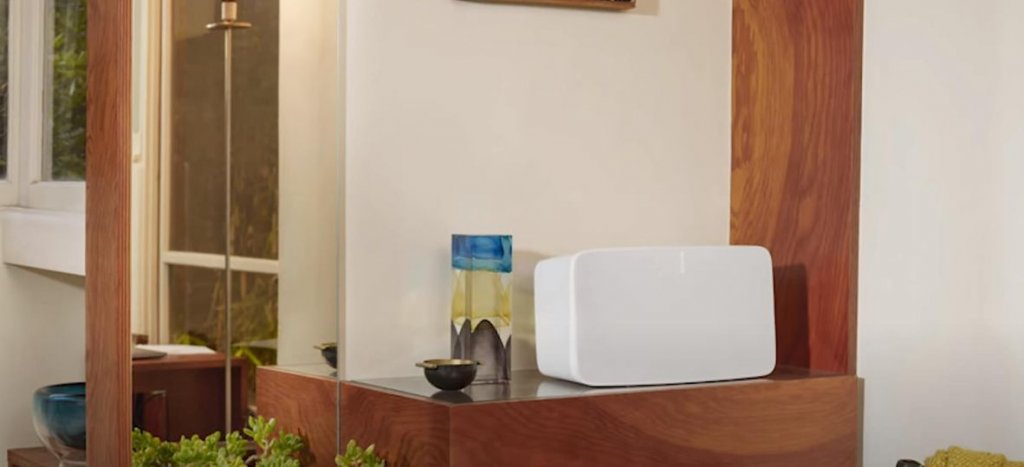
In a stereo pair, you’re getting close to wired sound from a pair of wireless speakers. Put these on some floor stands on either side of a console table, and you’ve got one beautiful looking and sounding audio setup. However, when buying a pair, this does put them in the price range of the award-winning KEF LSX, which are fantastic sounding speakers. Therefore you would need to weigh up what you’re looking for. If you want to listen to high-resolution audio now or you’re looking to connect your speakers to a TV, then we would opt for the LSXs. These are also available in a more extensive range of colors such as blue, green, and red to suit your room decor. On the other hand, the Sonos 5 offer a complete experience from the streaming services available, additional features, methods of control and becoming part of a whole sound system.
Conclusion
Let’s move on to who we would recommend. If you have a Play 5 already, there isn’t any need to upgrade to the Five. While there are some minor differences, the sound and the performance remains pretty much the same. The Play Five has been a hugely popular speaker for Sonos since its first iteration was released in 2009. Besides some tweaks here and there, 5 fix something that isn’t broken. Suppose you’re considering a Play Five already. In that case, you’ll now be getting the latest model with a sleeker, more modern design and better internals for any future updates, especially since the new Sonos s2 app’s launch.
If you’re a real music lover and want to enjoy your favorite albums and artists, then the 5 is a good option. Whether you opt to use one alone to a stereo pair or take your home cinema set up to the next level using a pair as rears to a Sonos soundbar, you will experience bold sound with great detail. The dedicated line makes this an excellent option for vinyl enthusiasts, offering a gateway between older hi-fi and the modern Sonos system, giving you the best of both worlds. The main pros for the Five over the Play 5 are wide, vibrant room-filling audio, a refreshed sleek design, true Play tuning to help the speaker become more spatially aware of its environment, updated internals and future-proofed hardware. And, of course, the line-in option for connecting a turntable.
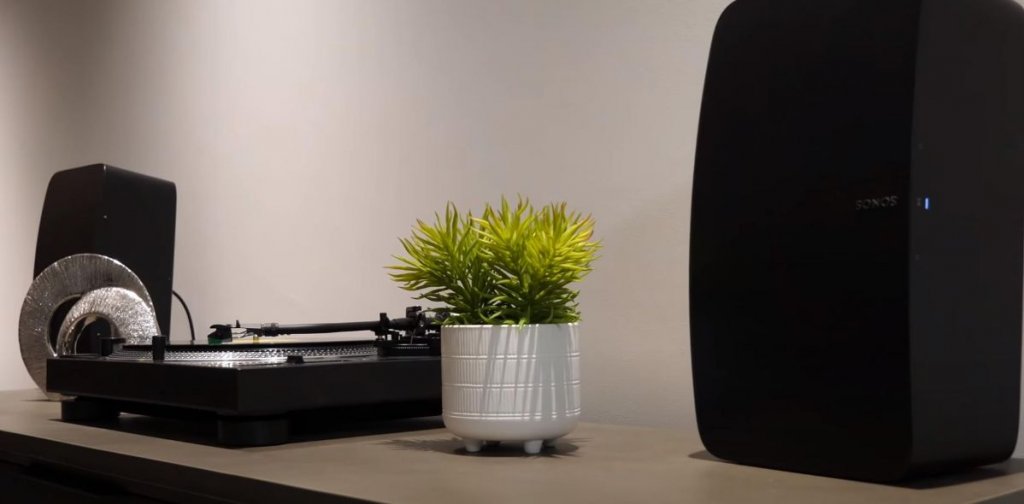
On the other hand, there’s no built-in voice control. It can’t be used in a stereo pair with an older Play 5, and it’s a Wi-Fi-only speaker with no support for Bluetooth. And that line-in does become disabled if the speakers are used as rears for a soundbar. It’s also up against some strong competitors at this price point.
This speaker has been designed with studio-quality sound. The new 5 retains all the features I love with a slight facelift and internal upgrades.
